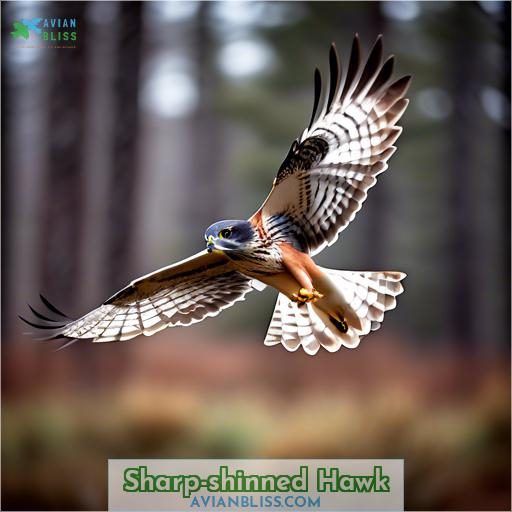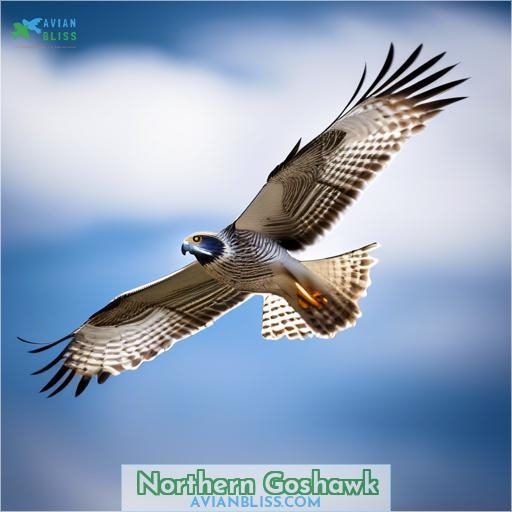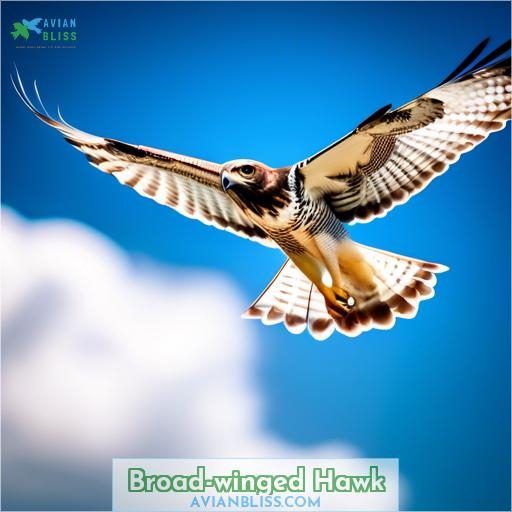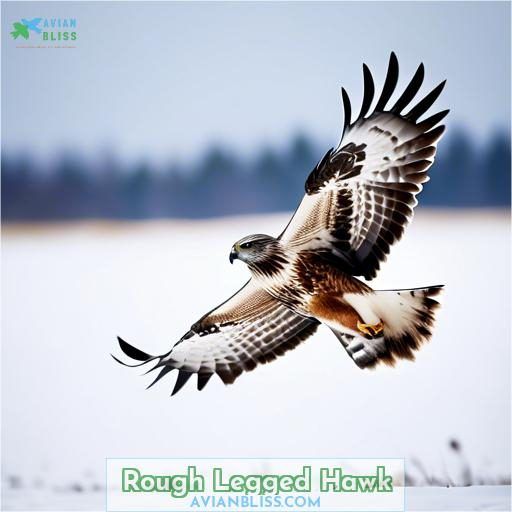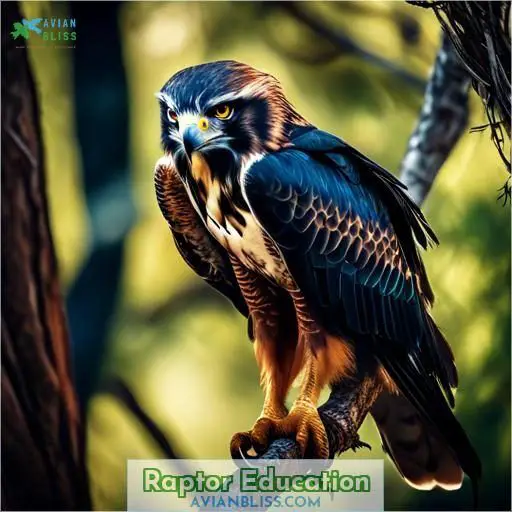This site is supported by our readers. We may earn a commission, at no cost to you, if you purchase through links.
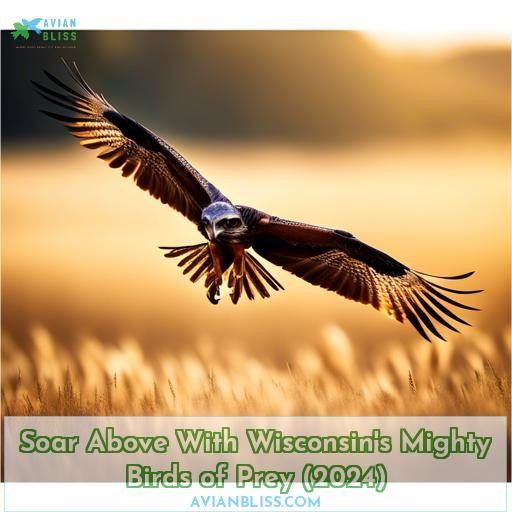
When you gaze skyward across Wisconsin’s verdant landscapes, you’ll be captivated by the majestic soaring silhouettes of the state’s mighty birds of prey. These raptors, including the adaptable Red-tailed Hawk, the acrobatic Sharp-shinned Hawk, and the apex predator Northern Goshawk, reign supreme as integral components of Wisconsin’s diverse ecosystems.
As indicators of environmental health, these Wisconsin birds of prey captivate birdwatchers and nature enthusiasts alike with their powerful hunting prowess and sheer grace in flight. Continue exploring to uncover the fascinating lives of these magnificent avian predators and their significance to the Badger State.
Table Of Contents
- Key Takeaways
- Red-tailed Hawk
- Sharp-shinned Hawk
- Cooper’s Hawk
- Northern Goshawk
- Northern Harrier
- Red-shouldered Hawk
- Broad-winged Hawk
- Rough Legged Hawk
- Osprey
- Raptor Education
- Frequently Asked Questions (FAQs)
- What is the habitat preference of Red-tailed Hawks?
- How do Red-tailed Hawks hunt and feed?
- What are the conservation status and threats to Red-tailed Hawks?
- How do Red-tailed Hawks differ from other similar species like Red-shouldered Hawks and Swainsons Hawks?
- What is the role of Red-tailed Hawks in urban environments and human-wildlife coexistence?
- Conclusion
Key Takeaways
- Wisconsin is home to a diverse range of birds of prey, including the Red-tailed Hawk, Sharp-shinned Hawk, Cooper’s Hawk, Northern Goshawk, Northern Harrier, Red-shouldered Hawk, Broad-winged Hawk, Rough-legged Hawk, and Osprey.
- These birds play a significant role in maintaining the balance of their ecosystems by controlling populations of small mammals, reptiles, amphibians, and other birds.
- Wisconsin birds of prey face threats such as habitat loss, pesticide exposure, and collisions with vehicles or man-made structures.
- Conservation efforts are essential to protect these birds and their habitats, including reducing environmental impact, supporting conservation organizations, and participating in local hawk watches.
Red-tailed Hawk
Soar above the skies with the mighty Red-tailed Hawk, a bird of prey known for its striking red tail and adaptability to various habitats. With a wingspan ranging from 38 to 43 inches, these birds are found in open to semi-open habitats, including forests, grasslands, and urban areas across North America. They’re versatile hunters, preying on small mammals, reptiles, amphibians, and other birds.
The Red-tailed Hawk’s conservation status is listed as Least Concern on the International Union for Conservation of Nature (IUCN) Red List, indicating a stable and widespread population. However, they may face local threats such as habitat loss, pesticide exposure, and collisions with vehicles or man-made structures.
These birds are known for their fast, high-pitched scream, Keeyer, Keeyer, Keeyer. They’re monogamous and may mate for life, building their nests in tall trees and incubating their eggs for four to five weeks.
Red-tailed Hawks are a common sight in Ohio, where they prefer drier upland habitats with elevated perches. They’re also found in open farmlands and fields, making them a familiar presence in many rural areas.
These birds aren’t only a sight to behold but also play an essential role in the ecosystem, controlling populations of small mammals and maintaining balance in their habitats, and are a welcome addition to any environment they inhabit.
Sharp-shinned Hawk
The Sharp-shinned Hawk is a small, agile bird of prey that’s often found in wooded areas and near the edges of forests. It’s one of the smallest hawks in North America, with a length of 9-13.5 inches and a wingspan of 16.5-26.5 inches. This hawk is known for its acrobatic abilities, allowing it to navigate through dense foliage and make quick turns while hunting.
Sharp-shinned Hawks are opportunistic ambush predators, often hovering or perching before diving on insects, lizards, small birds, and rodents. They’ve a preference for woodlands, woodlots, semi-open forests, and urban areas with many trees. These hawks are migratory, breeding north to the treeline in Alaska and Canada and wintering south to Panama.
The Sharp-shinned Hawk is smaller than the Cooper’s Hawk, but this isn’t a reliable trait to use for identification. The hawk’s head is more rounded and petite, and it has a more teardrop shape overall when compared to the Cooper’s Hawk. The Sharp-shinned Hawk’s tail feathers are closer to even in length, with less tail feather graduation than the Cooper’s Hawk. The hawk’s toes are also daintier and thinner than the Cooper’s Hawk’s.
Sharp-shinned Hawks are an important part of the food chain and ecosystem health. They’re indicators of ecosystem health, and a decline in their population can signal issues in the food chain or ecosystem. The hawk’s conservation challenges include habitat loss, which can affect their prey animals.
In Wisconsin, the Sharp-shinned Hawk is one of the raptors that can be seen in the Milwaukee area, along with owls, hawks, falcons, and Turkey Vultures.
Cooper’s Hawk
The Cooper’s Hawk, a master of stealth and adaptability, is a bird of prey that hunts a variety of prey, from small birds to mammals, and even reptiles. Known for its agile hunting strategies, it’s a formidable predator in the wild.
Territorial Behavior and Nest Construction
Cooper’s Hawks are monogamous, and many pairs mate for life. They breed once per year and raise one brood per breeding season. The male chooses the nest site, which is usually built in a tree, often in a crotch or where the trunk and a horizontal branch meet. Nests are cup-shaped and made from twigs and small branches, with the inside lined with softer materials such as bark, grass, or leaves. The female is usually responsible for building the nest, while the male brings her materials.
Hunting Strategies and Prey Preferences
These hawks are opportunistic feeders, hunting a wide variety of prey. They’re primarily bird hunters and have been known to hang around backyard bird feeders, where songbirds gather in tempting numbers. They generally hunt small- to medium-sized birds, including doves, quail, and woodpeckers. They may also catch bats, mice, and squirrels, and less often even frogs and snakes. They’ve been known to take an occasional fish and even other, smaller raptors, such as the American Kestrel.
Population Trends and Conservation
Cooper’s Hawks have faced threats in the past, such as habitat loss and hunting, which led to a decline in their population. However, their population has once again reached stable numbers, and they’re considered quite common over most of their range. They still face threats, including habitat loss, collisions with vehicles and power lines, and being shot.
Comparing Cooper’s Hawk with Other Raptors
When compared to other raptors, the Cooper’s Hawk stands out for its adaptability and hunting strategies. It’s a smaller hawk, with a length of 13.5-20 inches and a wingspan of 24.5-35.5 inches. This makes it more agile and able to navigate through dense forests, where it often hunts. It’s also a diurnal bird, meaning it’s active during the day, unlike the Peregrine Falcon, which is the fastest animal on the planet and is active during the day and at night.
Northern Goshawk
After honing in on the stealthy Cooper’s Hawk, let’s shift our gaze to the Northern Goshawk, a formidable Wisconsin bird of prey. This apex predator‘s keen eyesight makes it a master of hunting in dense habitats, swooping with precision on unsuspecting prey.
Despite its prowess, the goshawk isn’t immune to environmental factors and habitat loss, underscoring the importance of conservation efforts. As migratory patterns ebb and flow, the Northern Goshawk remains a symbol of nature’s untamed freedom and the raw power of the wild.
Northern Harrier
Imagine gliding over Wisconsin’s marshes, embodying the liberation of the Northern Harrier. This bird of prey’s hunting techniques are a spectacle of aerial acrobatics, swooping low with a sharp eye for prey. Its distinctive white rump flashes against the marsh habitat, a testament to its mastery in flight.
Unlike owls and vultures, the Northern Harrier employs both sight and sound for hunting, demonstrating a unique fusion of power and elegance. Embark on a journey of raptor education and uncover how these marsh guardians contribute to a harmonious ecosystem.
Red-shouldered Hawk
Soar above with the Red-shouldered Hawk, a magnificent bird of prey that can be found in Wisconsin’s woodlands and grasslands. This hawk is known for its striking appearance, with reddish shoulders, a rust-colored breast, and long, narrow wings with black and white stripes. Here are four things you mightn’t know about this bird:
- Habitat Selection: Red-shouldered Hawks prefer moist woodlands, such as bottomland hardwood forests or deciduous or mixed forests bordering lakes, streams, or other wetlands. They’re also found in suburban areas with wooded lots nearby.
- Prey Preferences: These birds have a diverse diet, feeding on small mammals like rabbits, rodents, and shrews, as well as small birds, snakes, frogs, lizards, fish, insects, and crayfish.
- Conservation Status: Red-shouldered Hawks are listed as a species of Least Concern by the IUCN. However, they face threats from habitat loss, which is the biggest concern for their population.
- Nesting Behavior: Red-shouldered Hawks build cup-shaped nests made of sticks, lined with dried leaves, bark, Spanish moss, lichens, feathers, and down. They usually nest between 20 and 60 feet above ground.
As you explore the skies of Wisconsin, keep an eye out for the Red-shouldered Hawk. Its presence is a proof of the health of the ecosystem, as it plays a significant role in maintaining a balance between predators and prey.
Broad-winged Hawk
Soaring above the treetops, the Broad-winged Hawk is a sight to behold. These medium-sized birds of prey are known for their distinctive black and white banding on their tails, as well as their wide wings that span from 29 to 40 inches. They’re a monogamous species, with pairs typically staying together for more than one breeding season.
Migration is a vital aspect of the Broad-winged Hawk’s life cycle. These birds are long-distance migrants, traveling from their breeding grounds in the eastern United States and southern Canada to their wintering grounds in southern Mexico, Bolivia, and Brazil. The fall migration is particularly impressive, with birds forming enormous flocks at migration bottlenecks that can number in the hundreds to tens of thousands.
Habitat preferences play a significant role in the Broad-winged Hawk’s life. They’re found in extensive forests throughout their breeding range, nesting near bodies of water and forest clearings as far away from human disturbance as possible. During migration, they roost on the edges of cloud forests, arid tropical scrub, and tropical forests.
Prey selection is another important factor in the Broad-winged Hawk’s lifestyle. These birds feed on a variety of prey, including small mammals, frogs, reptiles, and other birds. They’ve been known to consume crickets, mantises, grasshoppers, ants, caterpillars, and even earthworms.
Conservation efforts are essential for the survival of the Broad-winged Hawk. The species is classified as Least Concern (LC) on the IUCN Red List, but faces threats such as forest fragmentation, particularly within its breeding range. Additionally, habitat destruction, especially in their wintering range, poses a significant threat to the population.
Education and awareness are key to safeguarding the Broad-winged Hawk. Citizen scientists can contribute valuable data by logging observations through eBird and iNaturalist. Supporting conservation organizations and participating in local hawk watches can also help guarantee the future of these magnificent birds of prey.
Rough Legged Hawk
As a winter visitor, the Rough-legged Hawk is a large, soaring hawk known for its feathered legs, an adaptation to its northern habitat. These birds are variable in plumage, with light and dark color phases and variations in between. Dark phases account for only ten percent of western Rough-legged Hawks.
The light phase has a distinctive light-colored head, in contrast to its dark upperside. The Rough-legged Hawk’s bill and feet are relatively small.
They nest in the Arctic, both in the Old and the New World, mostly in tundra. In winter, they inhabit open fields, plains, marshes, and farmland. These hawks are often found singly or in pairs, and they hunt by watching from a perch.
Their diet consists of lemmings, voles, ground squirrels, and other small mammals, as well as carrion, especially in the winter. Nests are built on cliffs, slopes, atop large rocks, or on the ground, or, when there are trees nearby, in a tree.
The female incubates the 3 to 5 eggs for 31 days while the male brings her food. After a few weeks, the female joins in the hunting. The young first begin to fly at 5 to 6 weeks of age, but remain with the adults for another 3 to 5 weeks.
Osprey
Ospreys are a unique and fascinating species of bird found in Wisconsin and beyond. These birds of prey are known for their distinctive white head and dark brown wings, as well as their impressive hunting techniques. Ospreys build large nests on the tops of trees or poles near bodies of water, which can be up to six feet in diameter and are made from sticks, twigs, and other materials. They’re monogamous birds, and pairs will often return to the same nesting site year after year.
Ospreys are skilled hunters, with specialized feet that can grip fish and a reversible outer toe that allows them to hold onto their prey while in flight. They soar high above the water in search of prey, and when they spot a fish, they dive down and plunge their talons into the water to grab it. Ospreys play an important role in the ecosystem by helping to control populations of fish species such as menhaden and herring.
In terms of identification, Ospreys have a white head and dark brown wings, with a wingspan of 4-5 feet. They’re also known for their distinctive hunting technique, which involves hovering over the water and plunging their talons into the water to catch fish.
Ospreys are also known for their nesting habits. They typically lay one to four eggs, which hatch after approximately 35 days. Both parents take turns incubating the eggs and caring for the chicks, which are completely dependent on their parents for food and protection. As the chicks grow, they become more independent and begin to practice hunting and fishing on their own.
Ospreys are also conservation-minded birds. They’re sensitive to disturbance during the nesting season, and it’s important to keep a safe distance from their nests to avoid causing stress or harm. We can also protect Ospreys and their habitats by reducing our environmental impact, such as reducing energy consumption, properly disposing of waste, and using eco-friendly products.
Raptor Education
Raptor education is an essential component of raptor conservation and ecology. It involves studying raptor biology, adaptations, and ecological roles, promoting raptor rehabilitation, and raising awareness about raptor issues. Raptor education** programs aim to provide schools, corporations, conventions, and gatherings of all sizes with innovative programs and seminars that connect people with nature. These programs often use live, non-releasable raptors to highlight environmental concepts and issues.
Raptor Academy offers a wide range of learning opportunities for those working with raptors under human care, including courses on raptor rehabilitation, housing, and nutrition. Additionally, universities like Boise State offer Master of Science in Raptor Biology programs, which deepen students’ knowledge and understanding of raptor biology and ecology.
Educational resources like the Raptor Education Foundation’s Raptor Adaptation student sheet and the Vermont Institute of Natural Science’s Raptor Biology field trip offer hands-on learning experiences for students, helping them grasp the key differences that make raptors successful in their unique niche.
Frequently Asked Questions (FAQs)
What is the habitat preference of Red-tailed Hawks?
Hey, you wanna know where those red-tailed hawks hang out? Listen up, my friend – these birds are the Jack of all trades, adapting to just about any habitat they darn well please! From forests to fields, they’re livin’ large.
How do Red-tailed Hawks hunt and feed?
You can catch Red-tailed Hawks boldly soaring above, then suddenly diving down to snatch unsuspecting rodents or rabbits with their powerful talons. These adaptable predators make quick work of their meals.
What are the conservation status and threats to Red-tailed Hawks?
The Red-tailed Hawk’s conservation status is Least Concern, but habitat loss and pesticides pose threats. Yet, their adaptability helps them thrive, so you needn’t fret – these resilient raptors will soar on.
How do Red-tailed Hawks differ from other similar species like Red-shouldered Hawks and Swainsons Hawks?
Ah, the Red-tailed Hawk – the jitterbug of the raptor world! While its cousins the Red-shouldered and Swainson’s Hawks have a more refined dance, this feisty flyer reigns supreme with its unmatched adaptability and sheer aerial prowess.
What is the role of Red-tailed Hawks in urban environments and human-wildlife coexistence?
Red-tailed Hawks thrive in urban areas, taking advantage of abundant prey like rodents and birds. Their adaptability allows them to coexist with humans, showcasing nature’s resilience in the face of development. You’ll often spot them soaring above city skyscrapers.
Conclusion
Truly, the Wisconsin birds of prey are nature’s aerial maestros, enthralling us with their extraordinary hunting skills and effortless elegance.
As environmental guardians, these raptors protect the delicate equilibrium of Wisconsin’s varied ecosystems.
From the versatile Red-tailed Hawk to the supreme Northern Goshawk, each species plays a crucial role, evoking awe and emphasizing the significance of safeguarding these majestic avian hunters for future generations.


